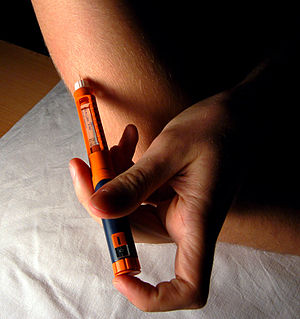 Image via WikipediaGEN | News Highlights:Firms Report Promising Data for Type 1 and 2 Diabetes Candidates at 71st Annual ADA Meeting
Image via WikipediaGEN | News Highlights:Firms Report Promising Data for Type 1 and 2 Diabetes Candidates at 71st Annual ADA MeetingThe American Diabetes Association (ADA) meeting in San Diego included the presentation of new data from Phase III trials evaluating Bristol-Myers Squibb (BMS) and AstraZeneca’s dapagliflozin, Boehringer Ingelheim and Eli Lilly’s linagliptin, and Novo Nordisk’s insulin degludec.
BMS and AstraZeneca reported positive long-term data from a Phase III clinical study evaluating their investigational sodium-glucose co-transporter-2 (SGLT2) inhibitor dapagliflozin, combined with metformin, for the treatment of type 2 diabetes. Data from the trial showed that the dapagliflozin-metformin combination maintained reductions in HbA1c levels from 52-weeks to 104-weeks, compared with combination therapy using the sulfonylurea glipizide and metformin. The study data also confirmed that patients treated with dapagliflozin added to metformin experienced 10 times less frequent hypoglycemic episodes than those treated using glipizide added to metformin. Participants in the dapagliflozin arm also maintained the weight loss they had achieved at 52 weeks through to 104 weeks, while patients in the glipizide therapy arm gained weight in the initial 52-week trial, and sustained this through to 104 weeks. The firms say the 104-week results are the longest-term clinical data presented to date for an SGLT2 inhibitor. A Marketing Authorization Application for dapagliflozin was validated by the European Medicines Agency in January. FDA accepted an NDA for the drug in March 2011, and has set the PDUFA date for October 28. BMS and AstraZeneca established their type 2 diabetes drug development collaboration back in January 2007. Boehringer Ingelheim and partner Eli Lilly, meanwhile, reported positive data from a Phase III study evaluating linagliptin (proposed trade name Trajenta® in Europe) combined with metformin in the treatment of type 2 diabetes. The results showed that the linagliptin combination therapy was as effective as glimepiride plus metformin in terms of lowering HbA1c levels over two years, but also led to a significantly lower incidence of hypoglycemia (7.5% vs. 36.1%, respectively) and a 54% relative risk reduction for cardiovascular events. Patients treated using linagliptin plus metformin also lost weight over two years, while those in the glimepiride-metformin treatment arm gained weight. Additional data from a pooled analysis of three Phase III studies showed that patients treated using linagliptin had HbA1c reductions independent of renal function, and in patients with severe renal impairment whose blood glucose levels weren’t otherwise sufficiently controlled, linagliptin provided clinically meaningful HbA1c reductions after 12 weeks of treatment. BI and Lilly established a collaboration to co-develop specific type 2 diabetes candidates in their respective pipelines, in January. Novo Nordisk’s presentations at the ADA meeting included data from two Phase III 52-week trials evaluating the ultra long-acting insulin, degludec, in patients with both type 1 and type 2 diabetes. The results showed that insulin degludec therapy led to HbA1c reductions of 0.4% in patients with type 1 diabetes, and 1.2% in those with type 2 diabetes, which was statistically noninferior to therapy with insulin glargine. In type 2 diabetes patients insulin degludec therapy was also associated with statistically fewer hypoglycemic events, averaging at 11.1 episodes per patient per year, compared with 13.6 episodes per patient per year for participants treated using insulin glargine. Rates of nocturnal hypoglycemia were 25% lower among both type 1 and type 2 diabetes patients receiving insulin degludec than among those taking insulin glargine. Additional trial data presented at the ADA meeting showed that insulin degludec could be dosed at different times from day to day (up to 40 hours apart) in type 2 diabetes patients without affecting overall glycemic control or risk of hypglycemia, compared with insulin glargine.

No comments:
Post a Comment
Note: Only a member of this blog may post a comment.